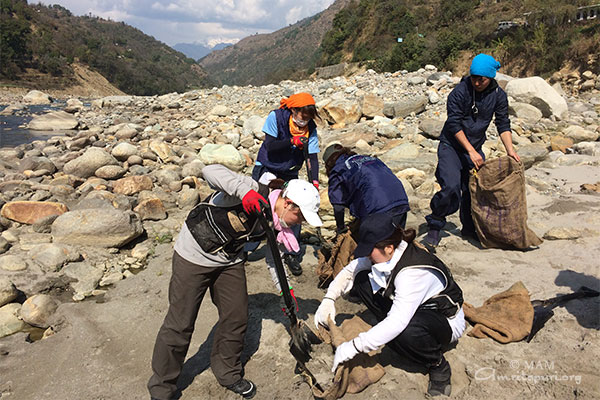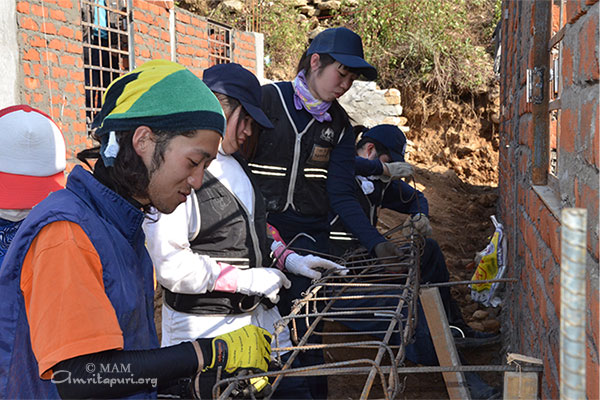February 2014, Uttarakhand
A group of 73 students from all over Japan came together and travelled to India to help take part in Amma’s rehabilitation of the areas devastated by the 2013 floods in the state of Uttarakhand. Amma pledged to rebuild 500 homes in the area. The first phase of that work is going on in and around the village of Chandrapuri in the district of Rudraprayag, on the way up to Kedarnath.

Students from the IVUSA (International Volunteer University Student Association) organization have collaborated with Embracing the World since 1998, participating in projects to build homes for tsunami refugees in both Kerala and Tamil Nadu after the 2004 Indian Ocean Tsunami, and more recently in 2011 and 2012 in Raichur, after devastating floods in Karnataka.
Many of the volunteers in this group were coming back to India for the second or third time for this purpose.
Remarkably for many of the students, these few weeks of time they spent volunteering, involving long days of hard physical labor, is their only vacation for the year. Inspired by Amma’s own life of dedication and service, they choose to spend this time not for their own enjoyment, but to do something for the benefit of the less fortunate.
Upon their arrival, the students were given a formal welcome and honored as official state guests by Chief Minister of Uttarakhand, Shri Harish Rawat. When addressing the students the Chief Minister said, “Amma is doing wonderful work and if you are with her your path in life will become clear.” The Chief Minister spent some time interacting with everyone and expressed his admiration and support for the students’ efforts.
Over the next several days the students were involved in all aspects of the construction work, including concreting, assembling the metal foundation beams, and transporting building materials from the riverbed up steep hills to the sites. The students are an extremely well organized group and divided themselves up into smaller teams, spreading out to work throughout the valley at all the different construction sites.
Each day when they showed up to do their seva they were met by scores of local villagers who were swept up by the Japanese students’ enthusiasm and compelled to join in the fun. With their open heartedness and spirit of selfless service, the students created joyful interactions, much to the amusement of their local Indian co-workers. Despite the work being very hard on a physical level no one minded. It was really like a party and everyone could be seen smiling and laughing as they worked.
Most of the work involved bringing building materials to the hamlet of Batwadi Sonar where a community hall is being built for the villagers. All day the students and villagers together hiked up and down the steep hill to the hamlet carrying stones and sand that will be used to build the hall. At the end of each day, just before the sun went down everyone would gather together around a giant Pipal tree in the village and sing bhajans together. While there might not have been any professional singers or musicians there, the innocence and beauty of the singing directly carried over from the joy and cooperation the students and villagers had shared working together all day. {Read Blogs here}
On their final morning of work the Japanese students introduced the local villagers to the Amala Bharatam Campaign. Again working side by side with all the locals, the Japanese students fanned out and collected trash throughout the area. Dozens of bags of trash were filled from the riverbed, which is sadly still full of debris from the flooding many months before.

Before leaving the Japanese students took part in a formal cultural program held at one of the local schools just down the road in the town of Chandrapuri. The Rudraprayag District Collector, Mr. Raghav Langar presided over the festivities which included many songs and dances performed by both the Japanese and local students and was attended by hundreds of local people.
When it was time to say goodbye, both the students and locals were sad to bid farewell to their newfound friends. They Japanese students donated their time, energy, and enthusiasm, but the volunteers said that they received much more than we gave.
In the sharing of loving care across cultural boundaries and language barriers, the line between “giving” and “receiving” disappeared, and volunteers and recipients find that they are not so different after all. In truth, even though they spoke Japanese and Garwhali, they share a common mother tongue: the universal language of Love.
– Nath











